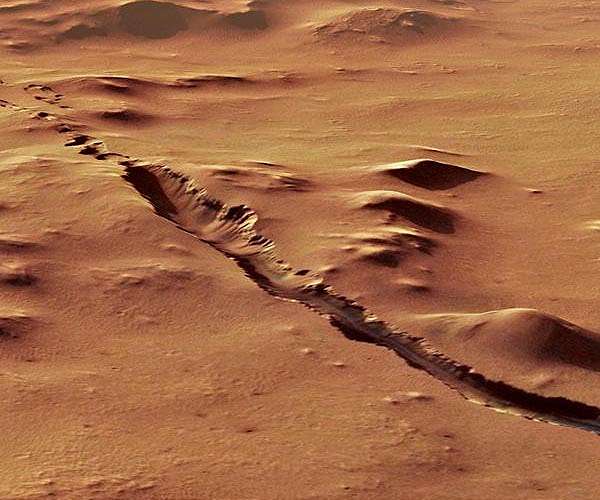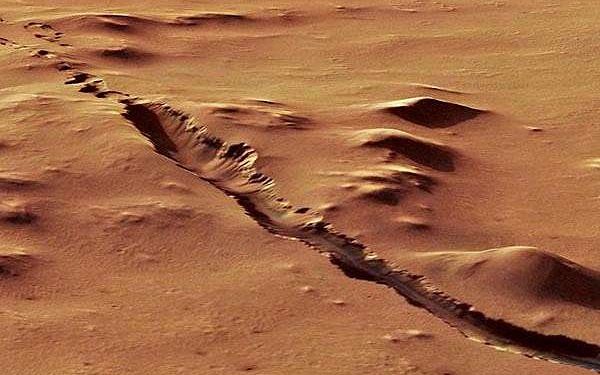
Recent volcanism on Mars reveals a planet more active than previously thought
by Daniel Stolte for UA News
Tucson AZ (SPX) Dec 21, 2023
A vast, flat, “featureless” plain on Mars surprised researchers by revealing a much more tumultuous geologic past than expected, according to a study led by researchers at the University of Arizona. Enormous amounts of lava have erupted from numerous fissures as recently as one million years ago, blanketing an area almost as large as Alaska and interacting with water in and under the surface, resulting in large flood events that carved out deep channels.
Lacking plate tectonics – shifting chunks of crust that constantly reshape Earth’s surface – Mars has long been thought to be a geologically “dead” planet where not much is happening. Recent discoveries have researchers questioning this notion, however. Just last year, a team of planetary scientists, also at UArizona, presented evidence for a giant mantle plume underneath the region Elysium Planitia, driving intense volcanic and seismic activity in a relatively recent past.
In the most recent study, a team led by Joana Voigt and Christopher Hamilton at UArizona’s Lunar and Planetary Laboratory combined spacecraft images and measurements from ground-penetrating radar to reconstruct in three-dimensional detail every individual lava flow in Elysium Planitia. The extensive survey revealed and documented more than 40 volcanic events, with one of the largest flows infilling a valley named Athabasca Valles with almost 1,000 cubic miles of basalt.
“Elysium Planitia is the youngest volcanic terrain on the planet, and studying it helps us to better understand Mars’ past as well as recent hydrological and volcanic history,” the authors write in their paper. Although no volcanic activity has so far been observed on Mars, “Elysium Planitia was volcanically much more active than previously thought and might even still be volcanically alive today,” said Voigt, the first author of the study, published in the Journal of Geophysical Research: Planets. A plethora of Mars quakes recorded by NASA’s InSight lander between 2018 until 2022 has provided proof that beneath its surface, the red planet is anything but dead.
“Our study provides the most comprehensive account of geologically recent volcanism on a planet other than Earth,” said Hamilton, associate professor at LPL. “It is the best estimate of Mars’ young volcanic activity for about the past 120 million years, which corresponds to when the dinosaurs roaming the Earth at their peak to present.”
The findings have implications for research surrounding whether Mars could have harbored life at some point in its history, according to the authors. Elysium Planitia experienced several large floods of water, and there is evidence that the outpouring lava interacted with water or ice, shaping the landscape in dramatic ways. Across Elysium Planitia, Voigt and her co-authors found ample evidence of steam explosions, interactions that are of great interest to astrobiologists because they may have created hydrothermal environments conducive to microbial life.
The team used images from the Context camera onboard NASA’s Reconnaissance Orbiter, or MRO, combined with even higher-resolution images from MRO’s UArizona-led HiRISE camera in selected areas. To obtain topographical information, they took advantage of data records from the Mars Orbiter Laser Altimeter on another NASA spacecraft, Mars Global Surveyor. These survey data were then combined with subsurface radar measurements taken with NASA’s Shallow Radar, or SHARAD, probe.
“With SHARAD, we were able to look as deep as 140 meters (460 feet) below the surface,” said Voigt, who completed the study as part of earning her doctoral degree at UArizona. She is now a postdoctoral researcher at Caltech’s Jet Propulsion Laboratory, or JPL, in Pasadena, California.
“Combining the datasets allowed us to reconstruct a three-dimensional view of the study area, including what the topography was like before lava erupted from multiple cracks and filled basins and channels previously carved by running water, Voigt added.”
Mars’ interior is thought to be very different from Earth’s, and a detailed reconstruction of its geological features provides scientists with glimpses into the processes that shaped it in the past. The relationship between volcanoes and the structure of the Martian crust is key to understanding the planet’s paleo-environmental conditions, Hamilton said. In addition to water contained within the magma being flung into the atmosphere and then freezing out on the surface, a volcanic eruption can allow for a catastrophic groundwater release onto the surface.
“When there is a crack in the Martian crust, water can flow onto the surface,” Hamilton said. “Because of the low atmospheric pressure, that water is likely to literally just boil away. But if there’s enough water coming out during that period, you can get a huge flood that comes through, racing over the landscape and carving out these huge features that we see.”
Understanding how water has moved around on Mars in the past and where it is today is a “holy grail” question, the authors said. Because the equatorial regions, where Elysium Planitia is located, are much easier to land on than the planet’s higher latitudes, the presence of water and understanding mechanisms of its release inform future human missions, which will critically depend on that resource.
“Elysium Planitia is the perfect location to try to understand the link between what we see at the surface and the interior dynamics that manifested itself through volcanic eruptions,” Voigt said. “I paid a lot of attention to the details on the lava surfaces to try and untangle the different eruption events and reconstruct the entire history of these geologic entities.”
The team plans to continue taking advantage of large, complex datasets obtained with different imaging methods to create highly detailed, three-dimensional insights of the Martian surface and what lies beneath, combined with a time sequence of events of other volcanically active regions.
Voigt likened lava flow surfaces to “open books that provide a wealth of information about how they came to be if you know how to read them.”
“These areas that used to be considered featureless and boring, like Elysium Planitia, I think they contain a lot of secrets, and they want to be read,” she said.
The work was supported by a NASA Future Investigators in NASA Earth and Space Science and Technology grant. Co-authors on the paper are Gregor Steinbrugge and Laura Kerber at JPL, S. Nerozzi, Jack Holt and Lynn Carter at UArizona’s LPL, and Michael Christofferson at the University of Alaska Fairbanks.
Related Links
Lunar and Planetary Laboratory
Mars News and Information at MarsDaily.com
Lunar Dreams and more
